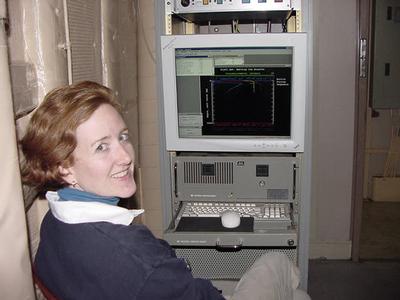18 August, 2001
In Search of Plumes
Dr. Hedy Edmonds, a chemical oceanographer from the University of Texas
Marine Science Institute, has been in search of hydrothermal plumes on our
expedition. She has brought with her 4 MAPRs (Miniature Autonomous Plume
Recorders)--instruments that are attached to the wires that go down in the
search for rocks. When the data collected by the MAPR shows signs of a
hydrothermal plume, the big daddy is pulled out-- the CTD.
The Healy has an instrument on board called a CTD, which stands for
conductivity, temperature, and depth. This instrument is used to collect
water samples around hydrothermal vents on the ocean floor. If you recall,
the CTD hadn't been working, but the Coast Guard electronic technicians
repaired it and it's ready to go.
Yesterday the MAPR went down in an area 3 times and the data it collected
showed the existence of a hydrothermal plume. This morning the decision was
made to turn the Healy around and head back 7 hours to this area and drop
the CTD. The CTD collects much more information than a MAPR can. It is a
huge piece of equipment with 24 bottles on it. Each bottle can hold 12
liters of water. The CTD works by sending data concerning the water's
conductivity (ability to conduct electricity, which is used to calculate
salinity), temperature, and its depth immediately to a monitor. This allows
the scientist to "fire" close each bottle and therefore trap water samples
from specific depths. The ship moves along, sometimes towing the CTD like a
yo-yo, while the 24 bottles are filled around a plume area. These water
samples are then taken to a lab where they are analyzed for amounts of
helium, methane, and manganese-three tracers of hydrothermal plumes.
Besides the hunt for plumes, everyone has been on the search for polar
bears. We had a nice surprise yesterday afternoon when one was sighted very
close to the ship. It was our first close look and it was exciting. The
bear would lumber along an ice floe, jump into the water and swim along,
then gracefully climb out onto the next ice floe. The crew watched this
huge animal in amazement as it continued its progress. It was quite a
sight!

We had our first close look at a polar bear!

Dr. Hedy Edmonds is monitoring the data from the CTD as is travels down to the bottom of the ocean. She is discovering the first hydrothermal plumes in the Arctic Ocean.
Contact the TEA in the field at
.
If you cannot connect through your browser, copy the
TEA's e-mail address in the "To:" line of
your favorite e-mail package.
|
